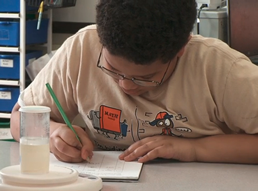Research Overview

The Inquiry Project research addresses three main questions:
- What changes occur as children move from judgments based on their direct experiences and their perception to a model-mediated understanding of matter?
- How does quantitative reasoning play a role in students’ changing understanding of matter?
- How effective is the Inquiry Curriculum in promoting such developments?
The longitudinal research focuses on students’ developing concepts of material, weight, volume, density, matter and state of matter from ages 8–11 (See Curriculum Grade 3, Grade 4, and Grade 5). Students at the same grade level, who received their school’s regular science instruction, serve as a control group for evaluating the impact of the Inquiry Project.
Our work builds on a long term learning progression for matter and the atomic-molecular theory showing that children’s initial concepts of object, material, size, and weight--each grounded in direct perceptual experience--must undergo major adjustments to become consistent what scientists now know about matter (Smith, Wiser, Anderson, & Krajcik, 2006; Wiser & Smith, 2008). For example,
- Young children initially believe that tiny objects have no weight.
- They fail to realize that liquids, solids and gases are made up of the same, invisibly small, building blocks.
- More generally, they believe that their unaided senses provide a trustworthy account of scientific phenomena. This overreliance on perceptual appearances interferes with learning about atoms, molecules and processes that cannot be directly observed.
Our work also builds on prior studies of the development of quantitative reasoning (Schliemann & Carraher, 1992; Carraher, 1996) showing that:
- People’s reasoning about physical quantities often differ in significant ways from reasoning about numbers.
- Proportional reasoning relies on a shift from numbers as counts to numbers as measures and as ratios.
Here we provide an initial glimpse into what we are learning from our longitudinal study about how elementary children begin to construct meaningful models of matter and materials both with and without the support of the Inquiry Curriculum.
REFERENCES
Carraher, D. W. "Learning About Fractions." (1996) In Theories of Mathematical Learning, edited by Leslie P. Steffe, Perla Nesher, Gerald Goldin, Paul Cobb and Brian Greer. Hillsdale, NJ: Erlbaum.
Schliemann, A. D. and D. W. Carraher (1992). Proportional reasoning in and out of school. In P. Light and G. Butterworth (eds.) Context and Cognition, Hemel-Hempstead, UK, Harvester-Wheatsheaf: 47-73.
Smith, C, M Wiser, C Anderson, and J Krajcik (2006). "Implications of Research on Children’s Learning for Standards and Assessment: A Proposed Learning Progression for Matter and the Atomic Molecular Theory." Measurement 14, no. 1 & 2, 1-98.
Wiser, M, and CL Smith (2008). "Learning and Teaching About Matter in Grades K-8: When Should the Atomic-Molecular Theory Be Introduced?" In S. Vosniadou (ed.) International handbook of research on conceptual change, Mahwah, N.J., Lawrence Erlbaum Associates, Inc.: 205-239.
The reports section contains links to Inquiry Project reports.



